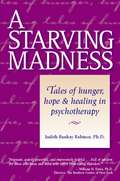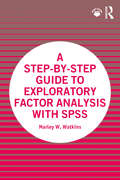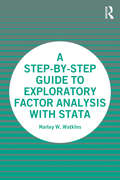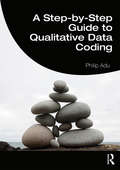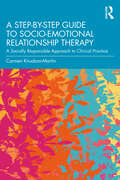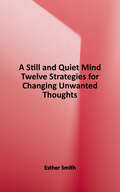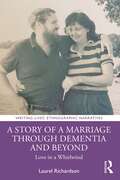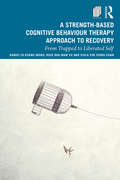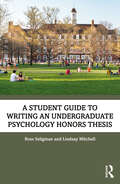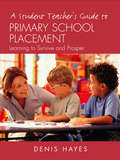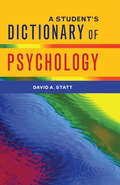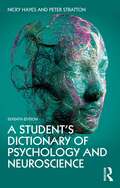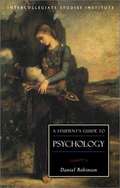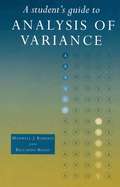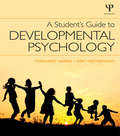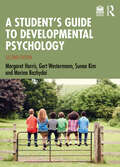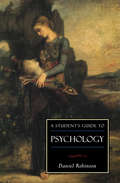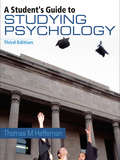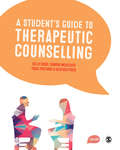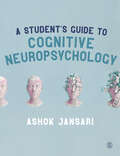- Table View
- List View
A Starving Madness
by Ph.D. Judith Ruskay RabinorJudith Ruskay Rabinor is a New York psychologist who specializes in eating and body image disorders. In this revealing book, she shares stories of actual clients seeking therapy and looks at the healing process of psychotherapy and the power of the relationship between therapist and client. Sufferers and their loved ones, as well as professionals will find hope and inspiration in these tales of transformation.
A Step-by-Step Guide to Applying the Rasch Model Using R: A Manual for the Social Sciences (Quantitative Methodology Series)
by Iasonas LamprianouThis new edition provides a step-by-step guide to applying the Rasch model in R, a probabilistic model used by researchers across the social sciences to measure unobservable (“latent”) variables. Although the focus is on simple R code, the book provides updated guidance through the point-and-click menus of BlueSky Statistics software.The book covers all Rasch models frequently used in social sciences, from the Simple Rasch model to the Rating Scale, Partial Credit, and Many-Facets Rasch models. Using a pragmatic approach to model-data fit, this book offers helpful practical examples to investigate Rasch model assumptions. In addition to traditional Rasch model approaches, it introduces the Rasch model as a special case of a Generalized Mixed Effects Model. Readers will also benefit from the online support material which includes all the code used in the book in downloadable and useable files.It also provides a comprehensive guide to R programming and practical guidance on using BlueSky Statistics software's point-and-click menus. This dual approach enables readers to experiment with data analysis using the provided data sets, enhancing their understanding and application of statistical concepts. It will be a valuable resource for both students and researchers who want to use Rasch models in their research.
A Step-by-Step Guide to Exploratory Factor Analysis with R and RStudio
by Marley W. WatkinsThis is a concise, easy to use, step-by-step guide for applied researchers conducting exploratory factor analysis (EFA) using the open source software R. In this book, Dr. Watkins systematically reviews each decision step in EFA with screen shots of R and RStudio code, and recommends evidence-based best practice procedures. This is an eminently applied, practical approach with few or no formulas and is aimed at readers with little to no mathematical background. Dr. Watkins maintains an accessible tone throughout and uses minimal jargon and formula to help facilitate grasp of the key issues users will face while applying EFA, along with how to implement, interpret, and report results. Copious scholarly references and quotations are included to support the reader in responding to editorial reviews. This is a valuable resource for upper-level undergraduate and postgraduate students, as well as for more experienced researchers undertaking multivariate or structure equation modeling courses across the behavioral, medical, and social sciences.
A Step-by-Step Guide to Exploratory Factor Analysis with SPSS
by Marley W. WatkinsThis is a concise, easy-to-use, step-by-step guide for applied researchers conducting exploratory factor analysis (EFA) using SPSS.
A Step-by-Step Guide to Exploratory Factor Analysis with Stata
by Marley W. WatkinsThis is a concise, easy to use, step-by-step guide for applied researchers conducting exploratory factor analysis (EFA) using Stata. In this book, Dr. Watkins systematically reviews each decision step in EFA with screen shots of Stata code and recommends evidence-based best practice procedures. This is an eminently applied, practical approach with few or no formulas and is aimed at readers with little to no mathematical background. Dr. Watkins maintains an accessible tone throughout and uses minimal jargon and formula to help facilitate grasp of the key issues users will face when applying EFA, along with how to implement, interpret, and report results. Copious scholarly references and quotations are included to support the reader in responding to editorial reviews. This is a valuable resource for upper level undergraduate and postgraduate students, as well as for more experienced researchers undertaking multivariate or structure equation modeling courses across the behavioral, medical, and social sciences.
A Step-by-Step Guide to Qualitative Data Coding
by Philip AduA Step-by-Step Guide to Qualitative Data Coding is a comprehensive qualitative data analysis guide. It is designed to help readers to systematically analyze qualitative data in a transparent and consistent manner, thus promoting the credibility of their findings. The book examines the art of coding data, categorizing codes, and synthesizing categories and themes. Using real data for demonstrations, it provides step-by-step instructions and illustrations for analyzing qualitative data. Some of the demonstrations include conducting manual coding using Microsoft Word and how to use qualitative data analysis software such as Dedoose, NVivo and QDA Miner Lite to analyze data. It also contains creative ways of presenting qualitative findings and provides practical examples. After reading this book, readers will be able to: Analyze qualitative data and present their findings Select an appropriate qualitative analysis tool Decide on the right qualitative coding and categorization strategies for their analysis Develop relationships among categories/themes Choose a suitable format for the presentation of the findings It is a great resource for qualitative research instructors and undergraduate and graduate students who want to gain skills in analyzing qualitative data or who plan to conduct a qualitative study. It is also useful for researchers and practitioners in the social and health sciences fields.
A Step-by-Step Guide to Socio-Emotional Relationship Therapy: A Socially Responsible Approach to Clinical Practice
by Carmen Knudson-MartinWriting to the practicing clinician, this book offers a step-by-step practical guide to Socio-Emotional Relationship Therapy (SERT) when working with individuals, couples, and families. Most therapists know sociocultural systems influence their clients’ lives, but few know how to connect the dots between what happens in the wider society, interpersonal neurobiology, relational processes, and client well-being. Written by a founder of SERT, Carmen Knudson-Martin draws on knowledge from multiple disciplines to innovatively weave together a practical step-by-step guide that demystifies the connections between micro and macro processes and relational/self-development. Divided into four parts, chapters cover how to conceptualize clinical issues through a socio-emotional lens, the therapist’s role in assessment, goal-setting, clinical decision-making, the “how-to” of each of the three phases of the SERT clinical sequence, and self-of-the-therapist work and clinical research that inform the model. The clear writing style and detailed examples make complex social processes accessible, demonstrating how good practice is—and must be—equitable and socially responsible. This practical guide is essential reading for all mental health professionals, such as seasoned family therapists, counselors, psychologists, social workers, and students in training in these fields.
A Still and Quiet Mind: Twelve Strategies for Changing Unwanted Thoughts
by Esther SmithAre you distracted by racing or anxious thoughts? Distressed by intrusive or irrational thoughts? Struggling with sinful or untrue thoughts? You may feel trapped in your head, but God and his Word have given you many different ways to find freedom. In this practical and sympathetic guidebook, biblical counselor Esther Smith provides twelve powerful strategies that are targeted to different thought struggles. Each chapter is filled with a variety of exercises so that you can begin to change your thoughts right away and live at peace.
A Story of a Marriage Through Dementia and Beyond: Love in a Whirlwind (Writing Lives: Ethnographic Narratives)
by Laurel RichardsonA Story of a Marriage Through Dementia and Beyond is the extraordinary, unflinching account from sociologist Laurel Richardson of her love and caregiving through the last period of her husband Ernest Lockridge's life - from his transient amnesia to his death from Lewy Body Dementia. Focusing on the lived experience of the caregiver through the loved one’s journey from mild cognitive impairment to death, the book gives the reader the experience of what the medical diagnoses mean and what has led up to the loss. It shows the complex, nuanced lives of a couple both living with the worst effects of a disease like Lewy Body Dementia, while maintaining, sometimes with hope and laughter, their loving connection nourished through a 40-year marriage. Dementia is a ‘silver tsunami’ - the third leading cause of death amongst senior populations. Richardson’s beautifully written book gives on-the-ground emotional support to those already in service as caregivers and helps prepare others for such service. Hospices, book clubs, and medical and allied professionals will find this book extraordinarily valuable. Weaving in autoethnographic and sociological methods and scholarship, as well as a list of reading and further resources for caregivers and scholars, this book will also appeal to courses in a wide range of disciplines and fields, including health communication, nursing and allied health, courses covering death and dying, end-of-life, and illness care, and, of course, scholars pursuing autoethnography, creative non-fiction, and qualitative methods.
A Strength-Based CBT Approach to Recovery: From Trapped to Liberated Self
by Daniel Fu Wong Rose Wai Yu Viola Yuk ChanThis is the first practice-oriented book to provide professionals with a clear and practical guide in delivering strength-based recovery-oriented CBT intervention. Essentially, strength-based CBT moves away from a deficit and rehabilitation model and offers a person with mental illness a sense of renewed hope and meaning of life. With plenty of case illustrations, the book integrates the recovery model and cognitive-behaviour approaches and provides readers with a theoretical understanding of the recovery process and how various cognitive-behaviour strategies can be skilfully applied to different stages of the recovery process. It is written for professionals such as psychiatrists, psychologists, social workers, occupational therapists and nurses in the mental health fields. Step-by-step illustrations of the use of the various cognitive behavioural strategies and worksheets are provided throughout the book.
A Student Guide to Writing an Undergraduate Psychology Honors Thesis
by Ross Seligman Lindsay MitchellA Student Guide to Writing an Undergraduate Psychology Honors Thesis takes students through the entire process of creating a full-scale research project, from selecting a topic, choosing an experimental or correlational design, to writing and presenting their paper. The book offers valuable guidance on developing broader skills like communicating with your supervisor, time management and critical writing skills. Chapters cover topics such as mentor selection, collecting journal articles, gathering and analysing data, and writing a full APA or BPS experimental paper and will orientate and guide psychology students as they navigate the expected components of an honors thesis. Designed for any student that is currently working on an independent research project, A Student Guide to Writing an Undergraduate Psychology Honors Thesis is the perfect companion for those working on their senior honours thesis in psychology.
A Student Guide to Writing an Undergraduate Psychology Honors Thesis
by Ross Seligman Lindsay MitchellA Student Guide to Writing an Undergraduate Psychology Honors Thesis takes students through the entire process of creating a full-scale research project, from selecting a topic, choosing an experimental or correlational design, to writing and presenting their paper. The book offers valuable guidance on developing broader skills like communicating with your supervisor, time management and critical writing skills. Chapters cover topics such as mentor selection, collecting journal articles, gathering and analysing data, and writing a full APA or BPS experimental paper and will orientate and guide psychology students as they navigate the expected components of an honors thesis.Designed for any student that is currently working on an independent research project, A Student Guide to Writing an Undergraduate Psychology Honors Thesis is the perfect companion for those working on their senior honours thesis in psychology.
A Student Teacher's Guide to Primary School Placement: Learning to Survive and Prosper
by Denis HayesSchool experience is the most significant part of learning to be a teacher. It can also be the most confusing, stressful and challenging. Initially, it can be very daunting to walk into someone else's classroom and try to prepare and teach effective lessons to someone else's class.It helps to have a clear idea of what to expect and to know how other people have coped, and in this book, Denis Hayes looks at what life is like for the student-teacher in the classroom. With plenty of down-to-earth and practical advice, he offers strategies for dealing with challenging situations and positive encouragement to help them succeed. The book covers four main areas: principles - summarises the fundamentals of successful teaching placement - provides detailed advice about preparing for, and prospering in, school placements, including case studies of trainee teachers' experiences practice - looks at practical issues in the classroom, including lesson planning, teaching skills, assessment and evaluation, and managing the classroom environment progress - covers applying for jobs and interview strategies, with newly qualified teachers talking about how they managed in their first few months.This text will be invaluable to anyone training to be a primary teacher and about to embark on his or her teaching experience. It will also be a useful resource for teacher mentors and course leaders of BEd, BA (Ed) and PGCE programmes.
A Student's Dictionary of Psychology
by David A. StattA Student's Concise Dictionary of Psychology contains over 1900 definitions from ablation to zygote. There are references to words, phrases and eminent psychological figures and David A. Statt has taken into account the most recent developments in psychology to present the definitions in a clear, instructive and concise manner.This book will be an invaluable source of information for students of psychology and its easily accessible style will make it an indispensable reference tool for those in related professions such as health and social work.
A Student's Dictionary of Psychology and Neuroscience
by Nicky Hayes Peter StrattonAn essential reference work for any student studying psychology for the first time, A Student's Dictionary of Psychology and Neuroscience (Seventh Edition) provides over 2,500 definitions of complex concepts in clear and accessible language alongside helpful diagrams. The dictionary offers comprehensive coverage of the main contemporary terms in psychology and neuroscience. This new edition features updated references which will be particularly relevant to the key areas of neuroscience and neuropsychology and also to recent concepts of psychological significance, such as expanded coverage of research methods, internet psychology, cognitive psychology and social psychology. The dictionary also features end material with useful notes for constructing student essays as well as key references and a list of common abbreviations. Extensive cross-referencing allows students to follow up and identify further details of a given topic, and mini-biographies of key psychologists help to provide relevant context. A Student's Dictionary of Psychology and Neuroscience is the perfect accompaniment for any student newly encountering this fascinating subject, those taking related disciplines in the health or social sciences, or professionals wanting to familiarise themselves with key terms and ideas.
A Student's Guide To Psychology
by Daniel RobinsonThe ISI Guides to the Major Disciplines are reader-friendly introductions to the most important fields of knowledge in the liberal arts. Written by leading scholars for both students and the general public, they will be appreciated by anyone desiring a reliable and informative tour of important subject matter. Each title offers an historical overview of a particular discipline, explains the central ideas of each subject, and evaluates the works of thinkers whose ideas have shaped our world. They will aid students seeking to make better decisions about their course of study as well as general readers who wish to supplement their education. All who treasure the world of ideas and liberal learning will be motivated by these original and stimulating presentations.
A Student's Guide to Analysis of Variance
by Riccardo Russo Maxwell J. RobertsIn the investigation of human behaviour, statistical techniques are employed widely in the social sciences. Whilst introductory statistics courses cover essential techniques, the complexities of behaviour demand that more flexible and comprehensive methods are also employed. Analysis of Variance (ANOVA) has become one of the most common of these and it is therefore essential for both student and researcher to have a thorough understanding of it.A Student's Guide to Analysis of Variance covers a range of statistical techniques associated with ANOVA, including single and multiple factor designs, various follow-up procedures such as post-hoc tests, and how to make sense of interactions. Suggestions on the best use of techniques and advice on how to avoid the pitfalls are included, along with guidelines on the writing of formal reports.Introductory level topics such as standard deviation, standard error and t-tests are revised, making this book an invaluable aid to all students for whom ANOVA is a compulsory topic. It will also serve as a useful refresher for the more advanced student and practising researcher.
A Student's Guide to Developmental Psychology
by Margaret Harris Gert WestermannThis major new undergraduate textbook provides students with everything they need when studying developmental psychology. Guiding students through the key topics, the book provides both an overview of traditional research and theory as well as an insight into the latest research findings and techniques. Taking a chronological approach, the key milestones from birth to adolescence are highlighted and clear links between changes in behaviour and developments in brain activity are made. Each chapter also highlights both typical and atypical developments, as well as discussing and contrasting the effects of genetic and environmental factors. The book contains a wealth of pedagogical features to help students engage with the material, including: Learning objectives for every chapter Key term definitions Over 100 colour illustrations Chapter summaries Further reading Suggested essay questions. A Student’s Guide to Developmental Psychology is supported by a companion website, featuring a range of helpful supplementary resources including exclusive video clips to illustrate key developmental concepts. This book is essential reading for all undergraduate students of developmental psychology. It will also be of interest to those in education, healthcare and other subjects requiring an up-to-date and accessible overview of child development.
A Student's Guide to Developmental Psychology
by Margaret Harris Gert Westermann Sunae Kim Marina BazhydaiNow in its second edition, this fundamental undergraduate textbook provides students with everything they need when studying developmental psychology.Thoroughly revised, this book breaks down key topics into easily accessible concepts and provides students with both an overview of traditional research and theory as well as an insight into the latest research findings and techniques. Taking a chronological approach, the key milestones from birth to adolescence are highlighted and clear links between changes in behaviour and developments in brain activity are made. A new chapter provides a global perspective on development, including findings regarding children’s motor, cognitive, literacy, social and emotional development, as well as the importance of cross-cultural studies and their challenges. Each chapter also highlights both typical and atypical developments, as well as discussing and contrasting the effects of genetic and environmental factors.This textbook comes with a wealth of carefully updated pedagogical features, designed to help students engage with the material, including:• Learning objectives for every chapter• Key term definitions• Over 100 colour illustrations• Chapter summaries• Further reading• Suggested essay questions.A Student’s Guide to Developmental Psychology is accompanied by a support material package, featuring a range of helpful supplementary resources including exclusive video clips to illustrate key developmental concepts, multiple-choice questions, flashcards and more.This book is essential reading for all undergraduate students of developmental psychology. It will also be of interest to those in education, healthcare and other subjects requiring an up-to-date and accessible overview of child development.
A Student's Guide to Psychology (ISI Guides to the Major Disciplines)
by Daniel RobinsonPsychology is frequently the most popular major on campus, but it can also be the most treacherous. In this guide, Daniel N. Robinson surveys the philosophical and historical roots of modern psychology and sketches the major schools and thinkers of the discipline. He also identifies those false prejudices--such as contempt for metaphysics and the notion that the mind can be reduced to the chemical processes of the brain--that so often perplex and mislead students of psychology. He ends by calling for psychology to investigate more intensively the problems of moral and civic development. Readers will find Robinson's book to be an indispensable orientation to this culturally influential field.
A Student's Guide to Studying Psychology
by Thomas M. HeffernanNow in its third edition, this very popular guide to studying psychology remains an invaluable tool for students at both undergraduate and pre-degree level, along with those deciding whether to take psychology as an academic subject. Providing insights into the most critical aspects of studying psychology, A Student's Guide to Studying Psychology is distinguished from other texts by its easy to follow format and practical nature. Topics covered include: * perspectives within psychology* making the most of seminars, tutorials and lectures* how to write essays and empirical reports* guidelines on exam preparation and technique* information on careers in psychology and tips for applying for jobs, including how to write your own curriculum vitae. For this fully updated third edition, new advice is included on web-based research and referencing. Subject coverage is expanded to include contemporary research trends in cognitive neuroscience, evolutionary psychology and positive psychology. In addition, new material investigates postgraduate specialisms including neuropsychology, psychotherapy and sport psychology.
A Student's Guide to Therapeutic Counselling
by Traci Postings Heather Price Kelly Budd Sandra McKeeverCo-published with the CPCAB, this highly practical book is a comprehensive training guide based around 7 core processes of practitioner development. This will appeal to learners on diploma courses at Level 4 and above. It offers a firm foundation of knowledge and skills, looks at practice issues, helps with study, and also answers the most common questions students have when training.
A Student's Guide to Therapeutic Counselling
by Traci Postings Heather Price Kelly Budd Sandra McKeeverCo-published with the CPCAB, this highly practical book is a comprehensive training guide based around 7 core processes of practitioner development. This will appeal to learners on diploma courses at Level 4 and above. It offers a firm foundation of knowledge and skills, looks at practice issues, helps with study, and also answers the most common questions students have when training.
A Student′s Guide to Cognitive Neuropsychology
by Ashok JansariAre all brains the same? What causes amnesia? And why did a man mistake his psychologist for George Michael? Find out the answers to these questions, and much more, in A Student′s Guide to Cognitive Neuropsychology. Written in an informative and accessible style, this comprehensive text guides you through the traditional areas of cognitive neuropsychology and beyond, applying core theoretical principles to real-world scenarios. Covering topics from memory to facial recognition, and from language to neglect, this textbook is essential reading for any student of cognitive neuropsychology. A Student′s Guide to Cognitive Neuropsychology also includes features to help enhance your understanding of cognitive neuropsychology, such as: Important researcher spotlights Key research studies Questions for reflection Further reading Ashok Jansari is Senior Lecturer in Cognitive Neuropsychology at Goldsmiths, University of London.
A Student′s Guide to Cognitive Neuropsychology
by Ashok JansariAre all brains the same? What causes amnesia? And why did a man mistake his psychologist for George Michael? Find out the answers to these questions, and much more, in A Student′s Guide to Cognitive Neuropsychology. Written in an informative and accessible style, this comprehensive text guides you through the traditional areas of cognitive neuropsychology and beyond, applying core theoretical principles to real-world scenarios. Covering topics from memory to facial recognition, and from language to neglect, this textbook is essential reading for any student of cognitive neuropsychology. A Student′s Guide to Cognitive Neuropsychology also includes features to help enhance your understanding of cognitive neuropsychology, such as: Important researcher spotlights Key research studies Questions for reflection Further reading Ashok Jansari is Senior Lecturer in Cognitive Neuropsychology at Goldsmiths, University of London.
